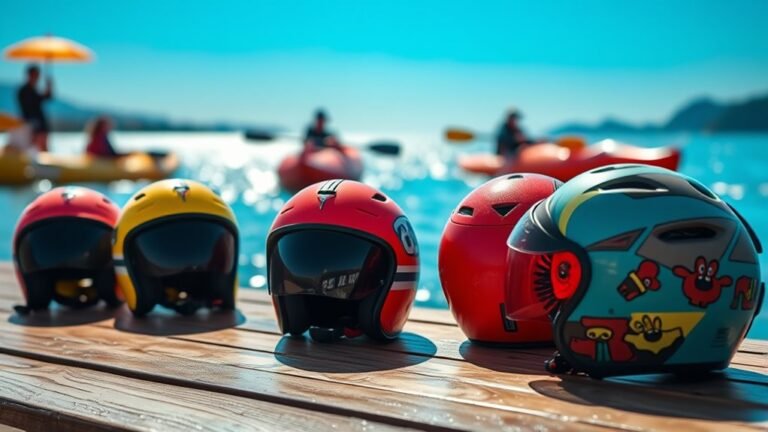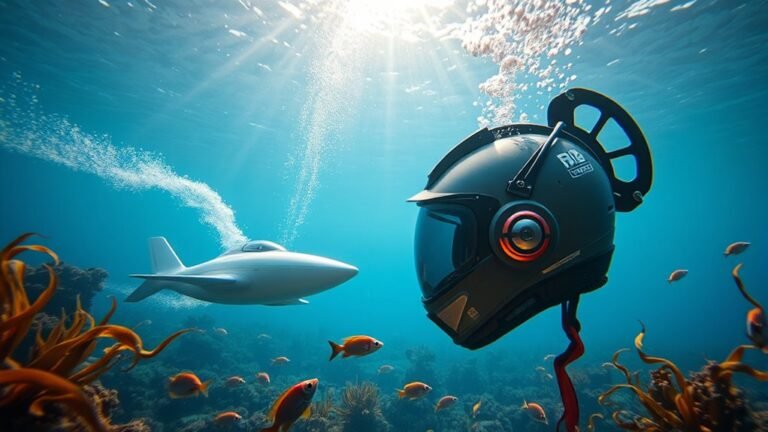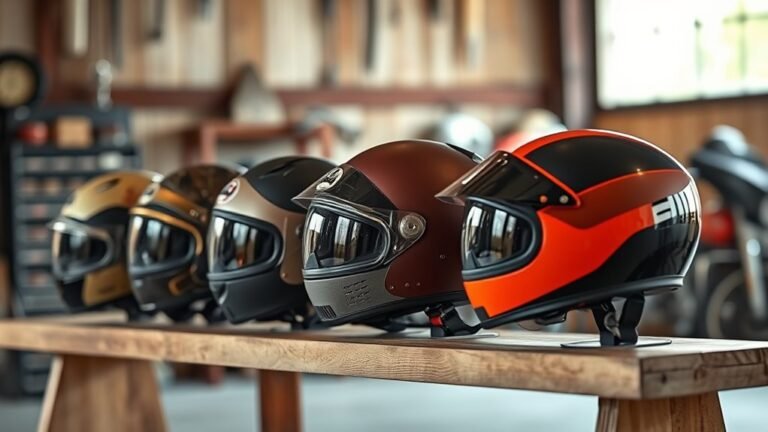Best Lightweight Helmets for Water Activities
For the best lightweight helmets for water activities, prioritize comfort, fit, and safety features like ventilation and durability. Look for brands known for quality, such as Sweet Protection and WRSI for kayaking, or guarantee your jet skiing helmet has impact ratings and a snug fit. Bright colors can also improve visibility on the water. When you select the right helmet, you’ll enjoy your water sports with more confidence and safety, and there’s more info ahead on the perfect choices.
Importance of Lightweight Helmets for Water Sports

When you’re out on the water, safety shouldn’t take a backseat to comfort, which is why lightweight helmets are essential for water sports. These helmets offer significant benefits of comfort, allowing you to stay focused on your performance rather than on cumbersome gear. A well-fitted, lightweight helmet won’t weigh you down, giving you the freedom to move with agility and confidence. This can be particularly vital during high-speed activities like wakeboarding or kayaking, where every ounce matters. By enhancing your performance, a lightweight helmet helps you push your limits while ensuring you stay protected. Ultimately, prioritizing comfort and safety can elevate your experience, allowing you to fully enjoy the thrill of water sports without unnecessary distractions.
Key Features to Look for in a Water Helmet
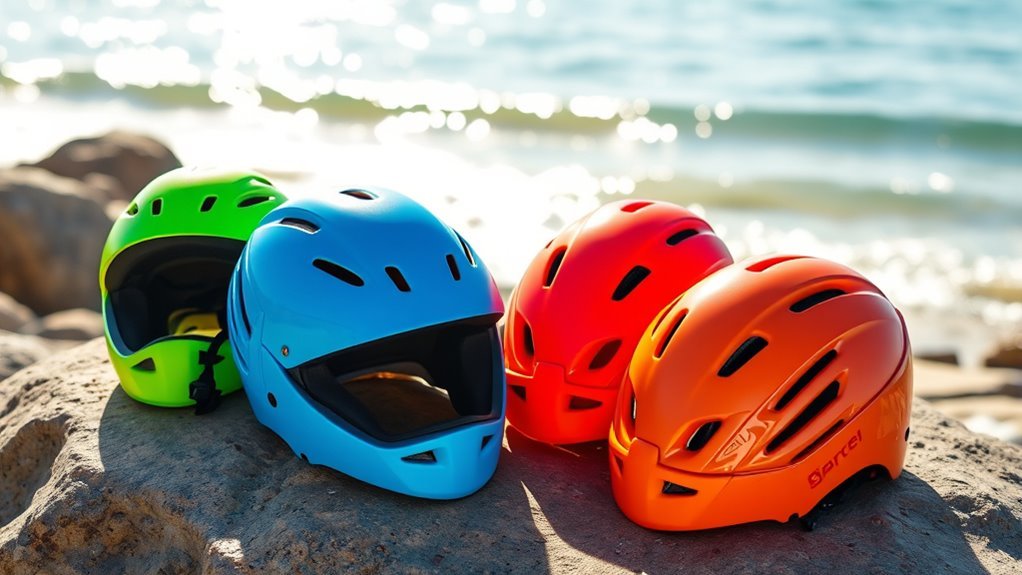
Choosing the right water helmet can make all the difference in your safety and comfort on the water. Here are some key features to look for:
Selecting the ideal water helmet is crucial for ensuring your safety and enhancing your comfort while enjoying water activities.
- Comfort features: Verify padding and ventilation for a snug fit without overheating.
- Sizing options: Check for a range of sizes or adjustable fit systems to find the best match for your head.
- Weight: Opt for a lightweight design that won’t weigh you down during your activities.
- Durability: Look for materials that can withstand impacts and resist wear from water exposure.
- Certification: Make sure it meets safety standards for water sports to guarantee adequate protection.
With these features in mind, you can focus on enjoying your time on the water, knowing you’re well-protected!
Top Lightweight Helmets for Kayaking
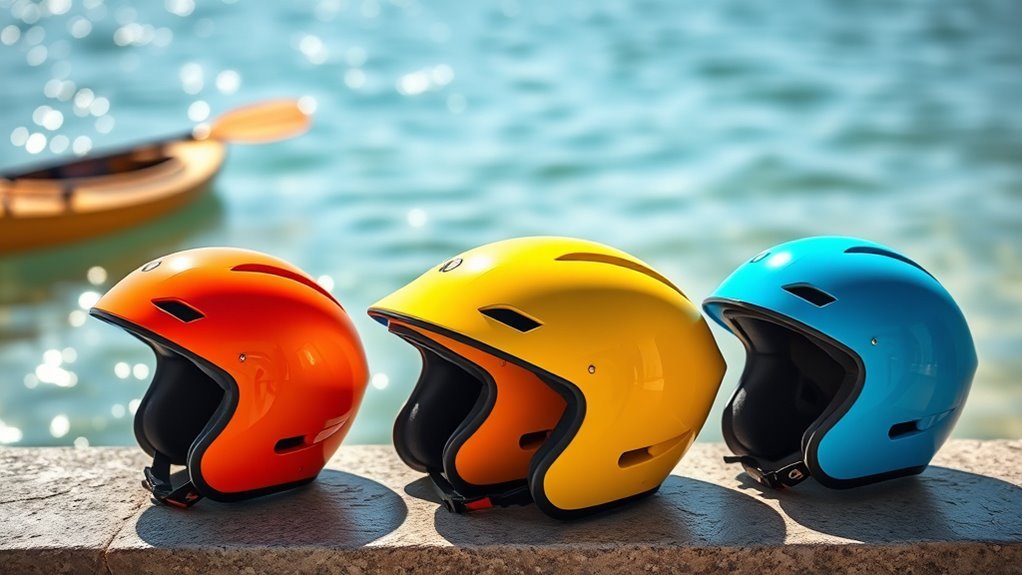
With the right features in mind, you can explore some of the top lightweight helmets specifically designed for kayaking. When it comes to kayaking safety, a good helmet is essential. Look for options made from durable yet lightweight helmet materials like ABS plastic or polycarbonate, which provide excellent protection without weighing you down. Helmets like the Sweet Protection Strutter or the WRSI Trident offer a snug fit and superior ventilation, keeping you comfortable on those long paddling trips. The NRS Chaos also features an adjustable fit system, ensuring it stays securely in place while you navigate rapids. Choosing the right helmet not only enhances your kayaking experience but also gives you the freedom to enjoy the water with peace of mind.
Best Lightweight Helmets for Jet Skiing
When jet skiing, having a lightweight helmet is essential for both comfort and safety. You’ll want to take into account helmets that offer robust safety features while still being easy to wear for long periods. Let’s explore some of the top lightweight models that can keep you protected on the water.
Safety Features Overview
While enjoying the thrill of jet skiing, you want to ascertain your safety isn’t compromised by a heavy helmet. Lightweight helmets are designed with essential safety features that prioritize your freedom and protection. Here’s what to look for:
- Impact assessment ratings: Confirm the helmet meets safety standards.
- Material durability: Choose helmets made from robust materials that withstand harsh conditions.
- Ventilation: Opt for designs that promote airflow, keeping you cool on hot days.
- Adjustable fit: A snug fit is vital for maximum protection.
- Visibility: Look for helmets with bright colors or reflective elements for increased visibility on the water.
With these features, you can enjoy your jet skiing adventure while feeling secure and unencumbered.
Top Lightweight Models
Choosing the right lightweight helmet for jet skiing can greatly enhance your experience on the water, as it combines safety with comfort. Look for models made from lightweight materials like carbon fiber or polycarbonate, which provide excellent protection without weighing you down. A good helmet should also feature a comfort fit, ensuring it stays snug yet comfortable during those exhilarating rides. Brands like JetPilot and O’Neill offer high-quality options that balance safety and freedom of movement. Don’t forget to check for adjustable straps and ventilation systems, as these enhance overall comfort. With the right helmet, you’ll feel secure and free to enjoy every wave you conquer. So gear up and ride with confidence!
Lightweight Helmets for Wakeboarding and Waterskiing
As you glide across the water’s surface, the last thing you want to worry about is your safety gear. Lightweight helmets designed for wakeboarding and waterskiing provide essential protection without weighing you down. They enable you to focus on perfecting your wakeboarding techniques and enjoying the thrill of the ride. When choosing a helmet, consider the following features:
- Lightweight materials for comfort and ease of movement
- Ventilation to keep you cool during intense sessions
- Adjustable straps for a secure fit
- Impact resistance to enhance waterskiing safety
- Stylish designs that match your personality
With the right helmet, you can ride with confidence, knowing you’re safeguarded while chasing the waves.
Stylish Options for Lightweight Water Helmets
When it comes to lightweight water helmets, you don’t have to sacrifice style for safety. There are plenty of fashionable designs and colorful patterns that let you express your personality while keeping your head protected. Whether you prefer bold colors or sleek styles, there’s a helmet out there that matches your vibe.
Fashionable Designs Available
Lightweight water helmets have come a long way from their utilitarian roots, now blending safety with style. You don’t have to compromise on fashion while ensuring your safety during water activities. Here are some trendy options and accessories you might love:
- Sleek, aerodynamic designs that minimize drag
- Customizable helmet stickers for a personal touch
- Vibrant colors that reflect current fashion trends
- Integrated visors for sun protection without sacrificing style
- Adjustable straps and padding for a snug fit
With these fashionable designs and helmet accessories, you’re sure to find a helmet that resonates with your adventurous spirit. So gear up, express yourself, and enjoy your water activities with confidence!
Colorful Patterns and Styles
Choosing a helmet doesn’t just stop at finding a sleek design; colorful patterns and styles can really elevate your water experience. Helmets with vibrant hues not only reflect your personality but also tap into color psychology, influencing your mood while you ride the waves. Bright colors can energize you, while calming shades may help you focus.
Staying on top of design trends means you can pick helmets that not only protect but also make a statement. From bold patterns to sleek gradients, there’s a style for everyone. When you’re out on the water, wearing a helmet that resonates with your vibe adds an extra layer of freedom and fun. So, don’t shy away—embrace your unique style!
Maintenance Tips for Your Water Helmet
Although water helmets are designed to withstand the rigors of aquatic activities, proper maintenance is essential to guarantee their longevity and effectiveness. To keep your helmet in top shape, consider these maintenance tips:
- Regularly clean: Use mild soap and water, avoiding harsh chemicals.
- Dry thoroughly: Allow your helmet to air dry completely after use to prevent mold.
- Inspect for damage: Check for cracks or dents that could compromise safety.
- Store properly: Keep it in a cool, dry place away from direct sunlight.
- Avoid heavy loads: Never stack heavy items on top of your helmet during storage.
Frequently Asked Questions
Are Lightweight Helmets Suitable for All Water Activities?
Lightweight helmets can be suitable for many water activities, but they must meet safety standards and have an activity-specific design. Not all helmets are created equal; some are tailored for kayaking, while others are better for wakeboarding or surfing. You want to choose a helmet that provides the right protection for your chosen sport, ensuring you stay safe while enjoying the freedom of the water. Always check for certifications and fit before diving in!
How Do I Properly Fit a Lightweight Helmet?
To properly fit a lightweight helmet, start by determining your helmet sizing. Measure the circumference of your head just above your ears. When you put on the helmet, it should sit level and snug, but not too tight. You want to avoid any movement when you shake your head. Don’t forget to adjust the chin strap for a secure fit—after all, what’s the point of freedom if you’re not safe?
Can I Wear a Lightweight Helmet Over a Hat?
You can wear a lightweight helmet over a hat, but it depends on the hat styles and fit. Make sure the helmet fits snugly without compromising safety or comfort. Some hats may interfere with the helmet’s compatibility, affecting how securely it sits on your head. It’s best to try on both together, ensuring the helmet remains stable. Prioritize safety and freedom when enjoying your activities, and you’ll find the right combination!
What Materials Are Commonly Used in Lightweight Water Helmets?
When you’re kayaking down a river, you want a helmet that won’t weigh you down. Lightweight water helmets are often made from materials like carbon fiber, which offers excellent impact resistance while keeping the helmet light. This way, you can enjoy your adventure without feeling restricted. Other materials may include expanded polystyrene or advanced composites, but carbon fiber is a top choice for balancing protection and freedom of movement on the water.
How Do I Know When to Replace My Helmet?
You should replace your helmet when it shows visible signs of damage, like cracks or dents, or if it’s past its helmet lifespan, typically around 3 to 5 years. Check for any wear that might jeopardize safety standards. If you’ve had a significant impact while wearing it, even if it looks fine, it’s time for a new one. Prioritizing your safety guarantees you can enjoy your adventures with peace of mind.


